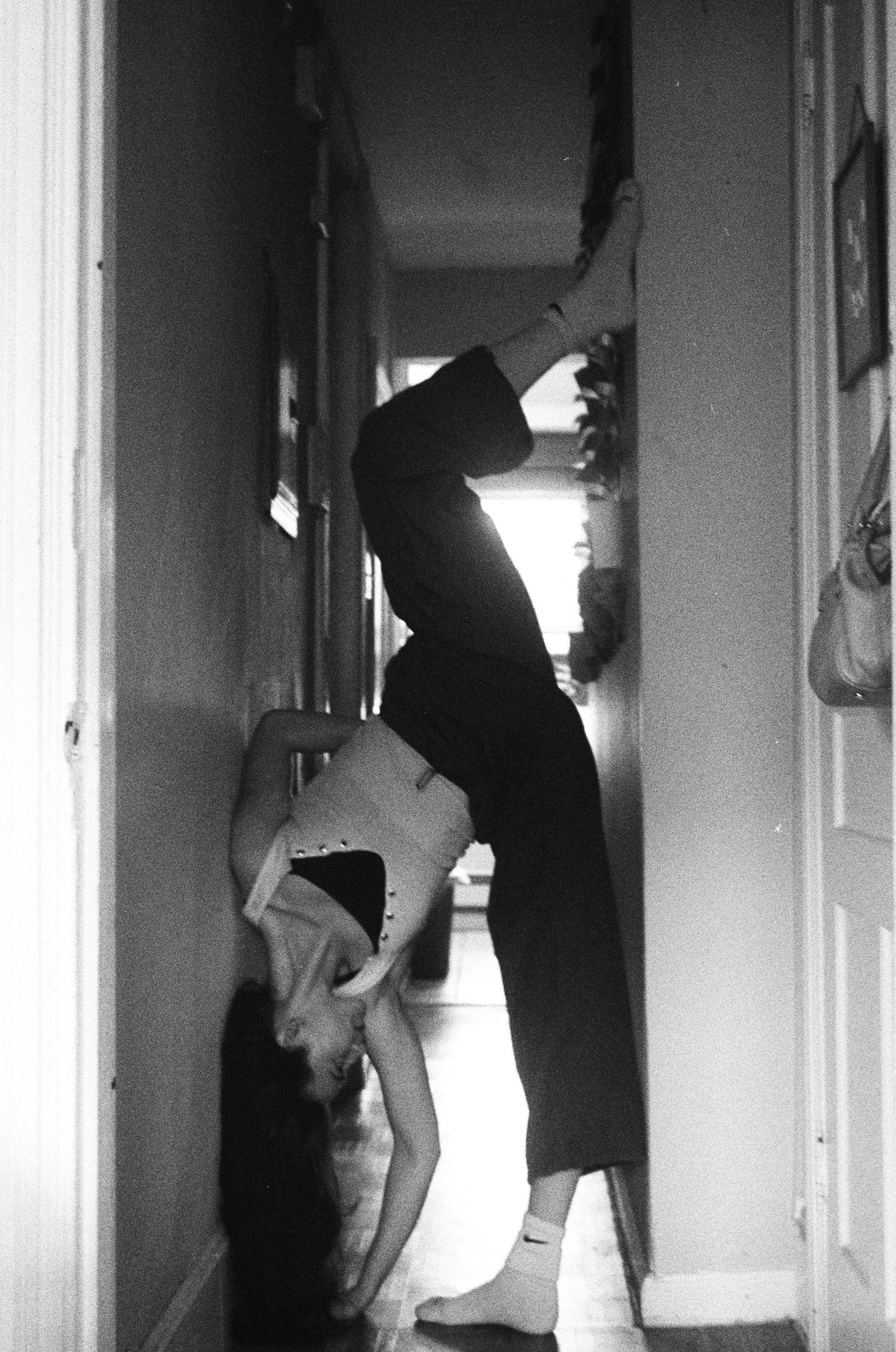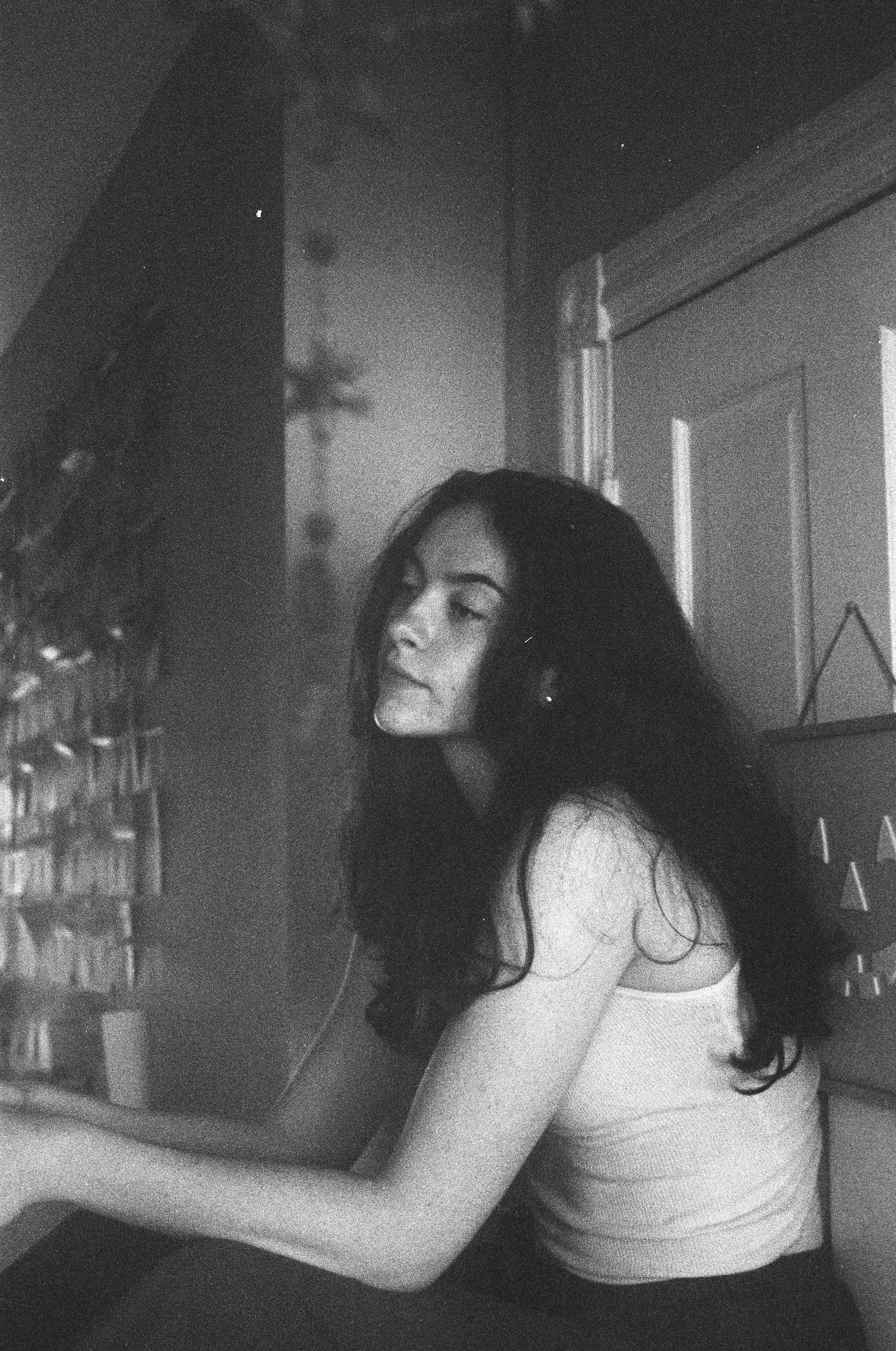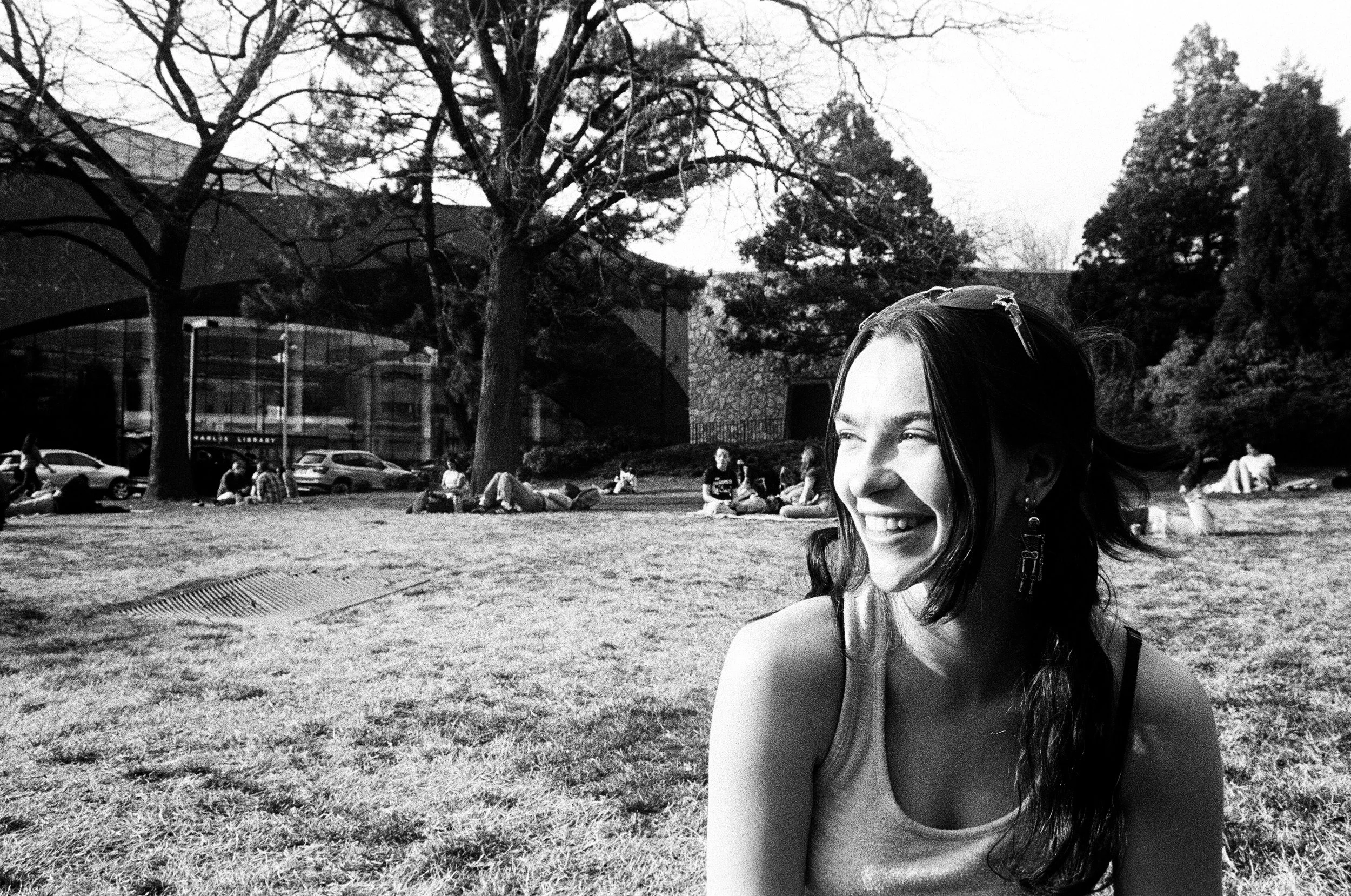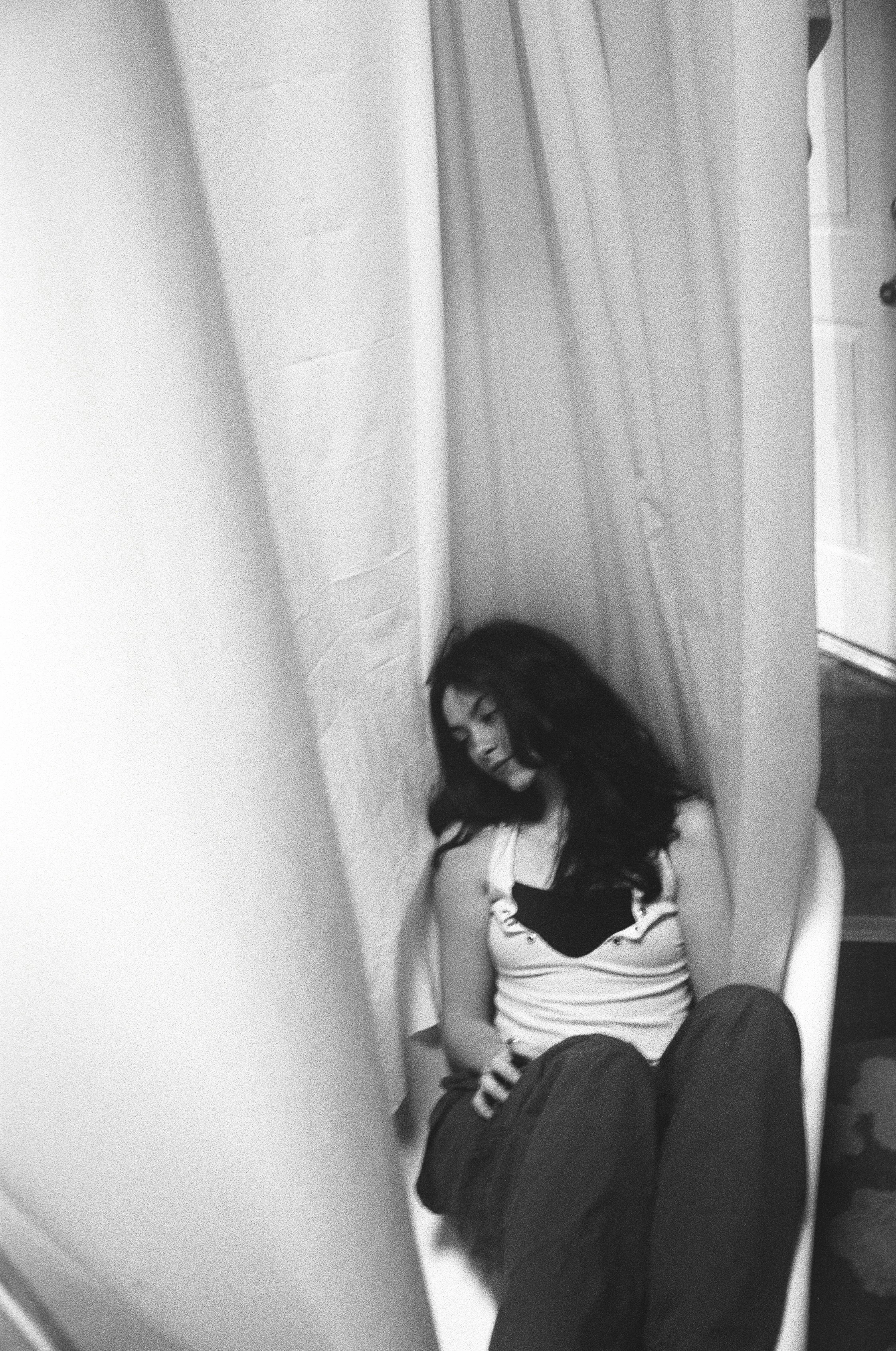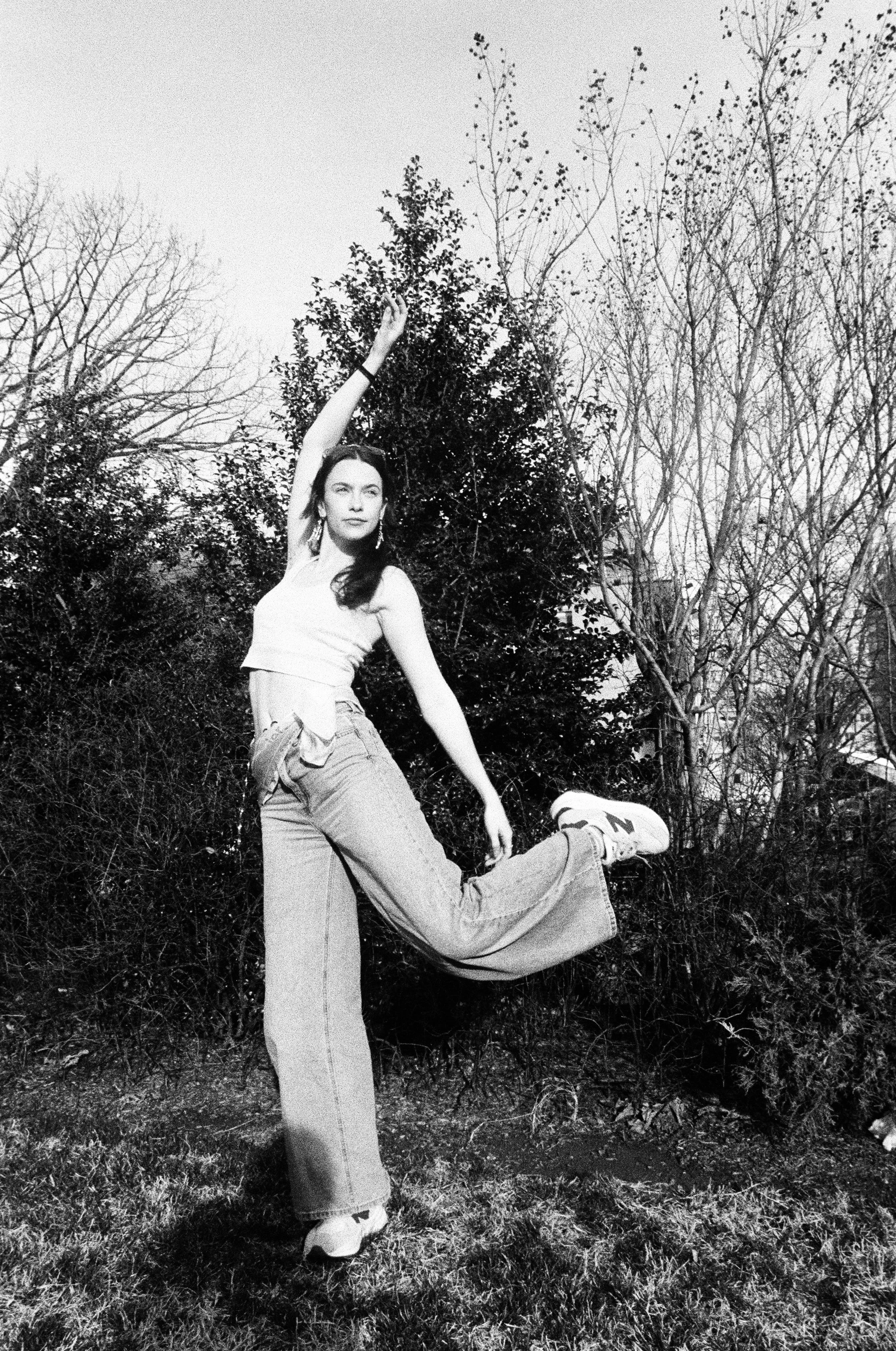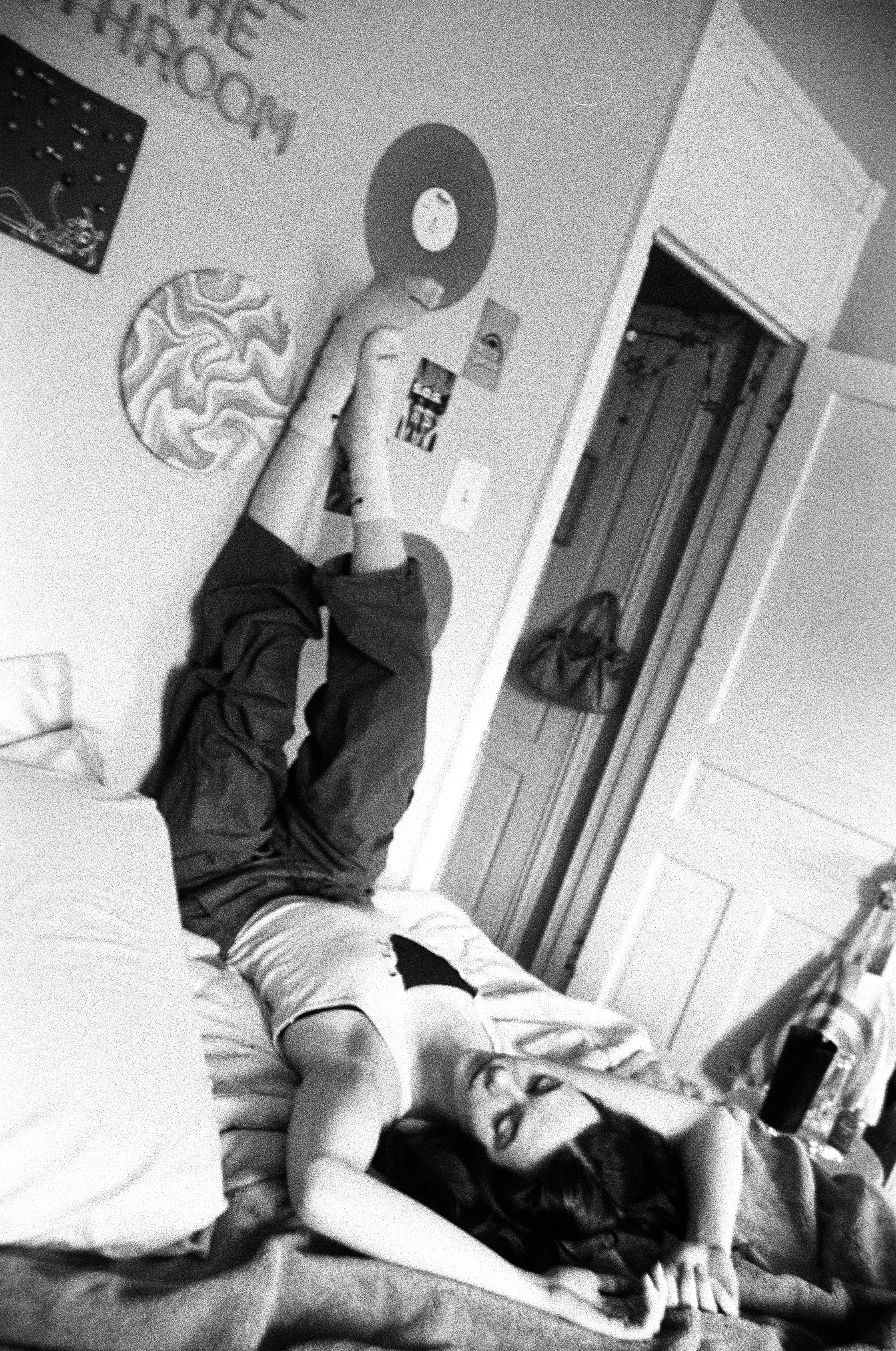MICHAELA DELANEY GUTHRIE
Michaela lives just down the street from me. She greets me at the door with her smiling pool of blue eyes, and after we climb three flights of stairs, both of us fighting to catch our breath, we find ourselves in our usual spot: lounging on her bed. I lean against the wall while she sprawls out at the foot of the mattress. Surrounded by walls of photos exhibiting the love in her life; friends old and new, some from photo booths around Philly, others polaroids from her life in Los Angeles. Every surface overflows with an eclectic collection of trinkets she's gathered over the years: variations of sunglasses, funky earrings, alien figurines. A little skeleton figure sits on her windowsill mid-stretch, and I see it as a portrait of her, I laugh at the resemblance. This room is her space at its core and it’s the spot where our best conversations and revelations have unfolded, but this time our ramblings center on something long overdue…
I met Michaela during our freshman year of college in the dorms. She was friends with my neighbors, and we spent much of that first year getting to know each other in their room. I remember we'd all say how college felt like summer camp; thrown into a community of strangers with no choice but to bond with them. Michaela was always great at breaking the ice, comfortable in her vulnerability and unafraid to ask the deeper, meaningful questions that helped us all understand each other's identities better. This expressive freedom within her has always inspired me. What I didn't realize until later was how much of it had been shaped, even magnified, by her life as a dancer, by her deep connection to her body and her comfort with being seen. At the end of many nights, she would curl up on their couch and sleep over.
While I was confined to my dorm room, scuttling through my notes (probably cramming for an exam the next day), I would picture her own late nights. Instead of studying, she was rehearsing with peers in a windowless room, spinning and rolling across the floor in front of mirrors. Their laughter echoed off the walls, filling the space with the light it so desperately needed.
It was naive of me to reduce Michaela’s passion to just that image, and I've learned how much deeper the world of dance runs through our growing friendship over the last four years.
People who know Michaela know her open energy and inviting laughter. They know the creativity in her outfits; the color coordination or wearing T-shirts the "wrong way" to invent a new look. You especially know that if there isn't enough room on the couch, she'll gladly take a seat on the floor, often stretching mid-conversation, touching her toes like it's second nature.
Even after years of friendship with Michaela, seeing her perform and hearing stories of her rehearsals, we'd never really talked about what dance means to her. I thought interviewing her for my first article could be the perfect opportunity for me to learn more about this part of her identity while also exercising a passion of my own: writing. What I discovered is that Michaela's transformation exists in the intention behind her passion: communication and expression. Her journey of overcoming the competitive structures that defined parts of her upbringing within dance and surrendering to the art tells the story of the dancer beyond the spotlight.
In understanding her soul, maybe you can understand yours too.
WELCOME TO EGO DEATH.
When Michaela talks about her earliest dance memories, there's a sense of inevitability in her voice. "I've been dancing forever," she says with a smile. "I started when I was three." But the path from childhood dancer to dedicated artist wasn’t exactly straightforward.
Before dance took center stage, Michaela was deeply involved in acting. When her small Massachusetts town couldn't provide the opportunities she needed, and her brother, who is on the spectrum, was facing bullying at school related to his needs, her family made the big decision to move to Los Angeles. They were seeking a more inclusive and supportive environment for her brother and better prospects for Michaela's artistic pursuits. So in middle school Michaela, her mom, and brother packed up their Ford F-150 and embarked on a cross-country journey.
Much of Michaela’s confidence in her art is credited to having parents that are both a support system and role models of the arts. Her mother's career as a dancer, actress, voice actress, chef, director, and now theatrical director has shown her that creative passions can also be professions. “She [My mom] never let me feel like being in the arts was not a path that I could choose. There was no hesitation of ‘you're not going to be able to be successful’ because I watched my mom growing up be successful doing what she loved.”
This living example has become Michaela's anchor. In moments of doubt, when strangers question her choices like "What are you going to do with a dance major?" or offer reactions that suggest dance is just a childhood hobby that you inevitably outgrow, something unsustainable for adult life, Michaela centers herself by remembering the why. Dance is something far more meaningful than just physical movement or performance; it's a medium that makes you feel. And she has proof, from the first person who loved her, that her path in the arts is not only viable but deeply worthwhile.
In California, she balanced acting, musical theater, and dance classes on the side, but noticed she was much more excited to go to her dance classes than she was to go to her acting classes. There was a connection to expression without language that aligned perfectly with what Michaela had discovered about herself: "I was in an acting class and I resonated with it in that I liked emoting, but I didn't always love speaking. I fell further into dance because I can still emote without having to say anything, and that feels more powerful to me." So when applying for high schools, she looked for dance programs rather than musical theater or acting. This was the first deliberate step toward claiming dance as her primary artistic expression.
When considering college options, Michaela sought an institution that would nurture both her dance career and her education in American Sign Language (ASL) and Temple University did just that. As a hard of hearing person, finding a school with a strong ASL program was essential to her, she worked over the four years to attain the ASL Certificate in Temple's College of Public Health. The requirements under this certificate allowed Michaela to broaden her knowledge of ASL and learn more about American Deaf culture.
What she didn't anticipate when choosing Temple University was how the competitive dynamics of dance would shift. The competition in LA created a world where you are set against your peers and broken down by the stakes of comparison. This competitive environment created tensions between performers that could fracture friendships and foster isolation. "When you're fighting against your community, you feel so alone," she reflects. The pressure wasn't just from teachers or choreographers but from dance parents too, creating a social ecosystem where artistic expression was overshadowed by competitive tensions.
Whereas Philadelphia's dance culture emphasized community and relationships over competition. Working everyday with a lot of the same people created a more familial relationship with her peers. Everyone really wants the best for each other, to see each other grow and do better, 'It put a different weight on my shoulders to be like, "Okay, I want to be a role model. I want to be someone that I can be proud of in this group of people rather than someone that is better than everybody else," she reflects.
Hidden Pieces - Directed & Choreographed by Robyn Bellah (featuring Michaela)
This emphasis on community aligned better with Michaela’s own personal perspective on comparison: "The mindset has shifted from 'that person's better than me' to looking at dancers that might have better technique or more emotion or different styles and thinking, 'How can I apply that to what I already know? I feel like that was just the shift I needed to make for myself, and something I apply in my day-to-day." Within the arts, comparison is still inevitable. But comparison is exhausting and takes away from the authentic self in your craft which is why Michaela has changed this comparison to an inspiration for the diversity in technique and perspective of her peers. "There are so many talented dancers in this department, and never once have I ever been like, 'I hate them because they're so much better than me.' It's like, 'I love you because you're so much better at this thing than me, and you inspire me to want to do better,' which I feel like is how it should be. I think that's how it should be in all aspects of life."
When Michaela moves, she's translating inner landscapes into physical form. Throughout our conversation, one theme emerged repeatedly: the connection between human experience and physical expression we encounter that makes dance uniquely powerful as an art form. She has to pull her own experiences and the observations of others to become what she needs to be in a performance. Having to pull different emotions and experiences within yourself to play the part which sometimes means reliving hard moments, "To convey a certain emotion or feeling to an audience, you first have to feel it within yourself," Michaela explains "that's why sometimes it can be so physically draining—we're not only working our bodies, but we're emotionally taxing ourselves to bring out that physicality."
While these experiences have been taxing, they’ve also sharpened Michaela’s sensitivity to nonverbal communication, not just in the studio, but in everyday life. “It’s made me really observant of people in general,” she shares. “When people are sad, what do they do with their bodies?” She slouches forward, her movements slow and heavy. “When people are insecure, how do they hold themselves?” She wraps her arms around her torso, shrinking inward. These observations have become tools, helping her read not just others, but herself. She’s learned to recognize her own emotional states by tuning into how her body responds. And by noticing how others carry themselves, she connects more deeply, meeting people where they are and understanding how best to approach them.
In those times where Michaela is feeling down, it sometimes pulls Michaela deeper into her dancing. She recalled a time where she wasn’t feeling great before class: "I never connected so much to the movement than that day. I was listening to the music and I was really feeling and reaching through every moment. I didn't want the movement to end." For Michaela, dance transcends expression, it's alchemy.
"People often say 'leave your stuff at the door and walk in and be your best self.' I'm so with that, but sometimes I think it's so much more powerful to instead bring it in with you." Dance allows her to not only channel her emotions but to release them, transforming raw pain into something beautiful and meaningful. In those moments of complete surrender to movement, her struggles become art worth witnessing, her vulnerability becomes strength, and her darkest feelings metamorphose into something that justifies their existence.
When Michaela takes the stage, it's like watching someone come home. There's an ease to her presence, she is comfortable with being in the spotlight. Unlike many performers, stage fright rarely visits her, but when it does, she sees it more as a collaborator than an enemy. "I feel like there's only performance anxiety when I don't feel confident in what I'm about to do, when I don't feel prepared," she explains.
I asked what advice she'd give to dancers struggling with performance anxiety and Michaela went straight to the heart of the fear.
"The first thing that comes to mind is: what is the worst thing that could happen?" She talks through the scenarios that keep performers up at night: forgetting choreography mid-performance, taking a fall in front of everyone, and then shrugs them off. These moments aren't disasters, she suggests, just parts of a dancer's journey. It is a risk you are taking to show yourself on stage, to be seen overall, you might fall, but there is something already so honorable to get up and dance in front of the world, that the failures don’t matter. "You're not always going to be at your best. So take the risk, see what happens because maybe you're going to surprise yourself. Those are the best moments when you doubt yourself and then you go in and think, 'Holy shit, I have never danced like that in my life.' It's such an exhilarating feeling."
Michaela has learned to see fear as part of the creative process rather than an obstacle to it. By embracing uncertainty rather than fighting it, she transforms nervous energy into something that actually enhances her dancing rather than diminishes it.
“You're never going to learn from playing it safe," she says. "I'm a huge advocate for stepping out of your comfort zone and living outside of the box as opposed to stepping outside of the box, take the risk. And I feel like as artists in general, you're already doing that, especially if you're pursuing it as a career."
"Movement is such a special thing," she shares with enthusiasm. "Something I truly believe is that everything is dance. If you sit in a park and watch people walk by, jump around, play with their kids, be on the phone, get in an argument, hug the person they love, hold hands with somebody—it's like watching a movement score. Life is dance. A flock of birds flying in formation is dance. We literally base our art off of our life and our experiences—the waves in the ocean, the sun in the sky, even the bees."
Movement transcends linguistic boundaries, offering a vocabulary that requires no translation. We intuitively understand the hunched shoulders and flailing hands of a heated argument, the gentle sway of comfort, the sharp edges of anger. Dance becomes a universal storyteller, conveying narratives that resonate across cultural divides. What fascinates me about Michaela's perspective is how she dissolves the boundaries between formal performance and everyday expression. Through her eyes, the subtle shift of weight when someone is uncomfortable, the expansive gestures of joy, or the synchronized rhythm of walking hand-in-hand with a loved one, these aren't just movements but expressions of our innermost states.
"Everything is dance," she says.

